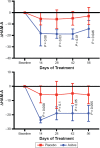Asenapine in the Treatment of Bipolar Depression
- PMID: 32214517
- PMCID: PMC7093720
- DOI: 10.64719/pb.4597
Asenapine in the Treatment of Bipolar Depression
Abstract
Objectives: Asenapine, a potent serotonin 7 (5-HT7) receptor antagonist, was examined for efficacy as an antidepressant in depressed bipolar subjects. It was predicted that subjects with the genetic variant of the short form of the serotonin transporter (5HTTR) would be more likely to respond.
Experimental design: A subset of patients participating in a randomized, placebo-controlled study of the efficacy of asenapine in bipolar I depression also underwent genetic testing for the 5HTTR. Montgomery Åsberg Depression Rating Scale (MADRS) score was ≥ 26 prior to randomization to asenapine or placebo for 8 weeks. Gene testing was performed before breaking the blind.
Principal observations: Nine patients completing the study also underwent gene testing. At study end, the average MADRS improvement was -19.80 ± SD 8.59 for the 4 people randomized to asenapine and -3.80 ± 9.01 for the 5 people receiving placebo (P = 0.021, t = 2.88). Anxiety, as measured by the Hamilton Anxiety Rating Scale (HAM-A), also improved in asenapine-treated patients (-15.40 ± 6.15 vs. -2.80 ± 7.95, P = 0.023, t = 2.803). Six participants had the short form of the 5HTTR, and it is believed they influenced the significant outcome in this small sample.
Conclusions: While this is a very small sample, asenapine appears to have a beneficial effect on both depression and anxiety in depressed bipolar I patients compared to treatment with placebo. Due to the large fraction of subjects with the short form, the hypothesis that the SF-5HTTR might increase asenapine response could not be adequately tested.
Keywords: anxiety; asenapine; bipolar depression; bipolar disorder; depression; serotonin transporter.
Copyright © 1964–2020 by MedWorks Media Inc, Los Angeles, CA All rights reserved. Printed in the United States.
Figures
References
-
- Fourth. Washington, DC: American Psychiatric Association; 2000. American Psychiatric Association. Diagnostic and Statistical Manual of Mental Disorders. Text Revision.
-
- Judd LL, Akiskal HS, Schettler PJ, Endicott J, Maser J, Solomon DA, Leon AC, Rice JA, Keller MB. The long-term natural history of the weekly symptomatic status of bipolar I disorder. Arch Gen Psychiatry. 2002;59(6):530–537. - PubMed
-
- Altshuler LL, Kupka RW, Hellemann G, Frye MA, Sugar CA, McElroy SL, Nolen WA, Grunze H, Leverich GS, Keck PE, Zermeno M, Post RM, Suppes T. Gender and depressive symptoms in 711 patients with bipolar disorder evaluated prospectively in the Stanley Foundation bipolar treatment outcome network. Am J Psychiatry. 2010;167(6):708–715. doi: 10.1176/appi.ajp.2009.09010105. doi: - DOI - PubMed
-
- Simon GE, Bauer MS, Ludman EJ, Operskalski BH, Unutzer J. Mood symptoms, functional impairment, and disability in people with bipolar disorder: specific effects of mania and depression. J Clin Psychiatry. 2007;68(8):1237–1245. - PubMed
-
- Baldessarini RJ, Vieta E, Calabrese JR, Tohen M, Bowden CL. Bipolar depression: overview and commentary. Harv Rev Psychiatry. 2010;18(3):143–157. - PubMed
LinkOut - more resources
Full Text Sources



